The SanDisk X400 1TB SSD Review
by Billy Tallis on May 6, 2016 9:00 AM ESTATTO
ATTO's Disk Benchmark is a quick and easy freeware tool to measure drive performance across various transfer sizes.
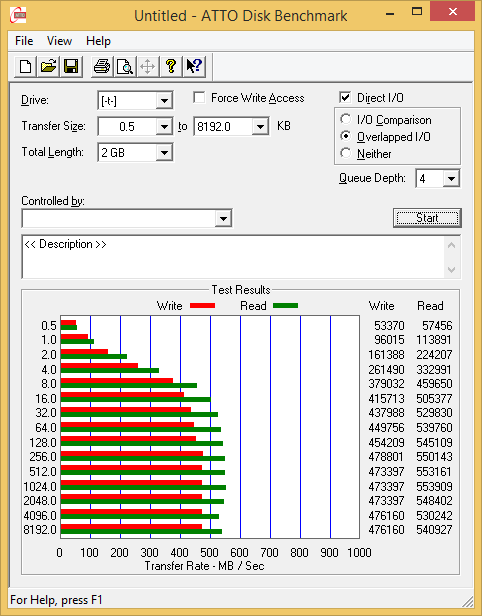 |
|||||||||
Aside from the write speeds that lag behind read speeds by a larger than normal margin, the ATTO results are reasonable and do not show signs of any major problems.
AS-SSD
AS-SSD is another quick and free benchmark tool. It uses incompressible data for all of its tests, making it an easy way to keep an eye on which drives are relying on transparent data compression. The short duration of the test makes it a decent indicator of peak drive performance.
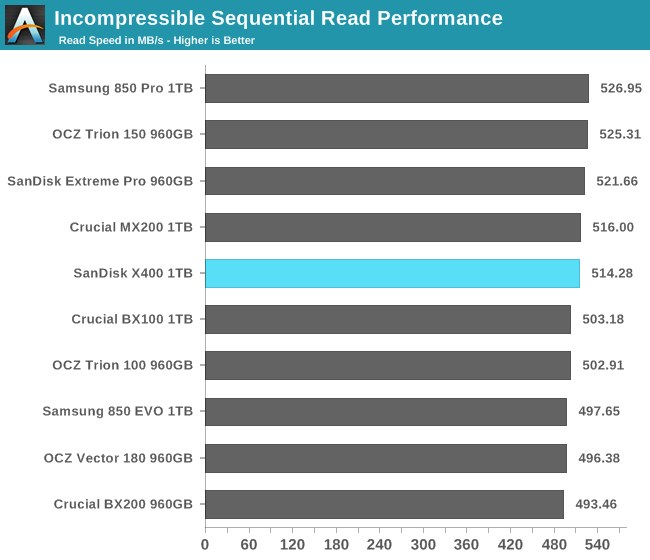
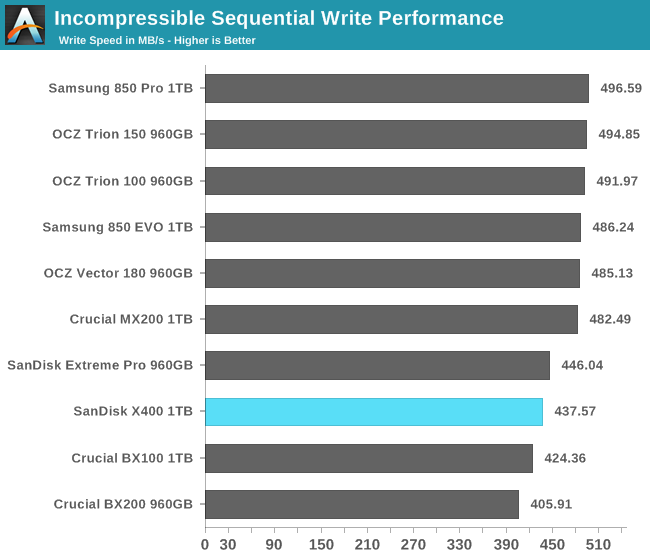
None of these drives show any meaningful difference in AS-SSD sequential read speed, but the write speed limitations of the X400 do show up clearly on this test.
Idle Power Consumption
Since the ATSB tests based on real-world usage cut idle times short to 25ms, their power consumption scores paint an inaccurate picture of the relative suitability of drives for mobile use. During real-world client use, a solid state drive will spend far more time idle than actively processing commands. Our testbed doesn't support the deepest DevSlp power saving mode that SATA drives can implement, but we can measure the power usage in the intermediate slumber state where both the host and device ends of the SATA link enter a low-power state and the drive is free to engage its internal power savings measures.
We also report the drive's idle power consumption while the SATA link is active and not in any power saving state. Drives are required to be able to wake from the slumber state in under 10 milliseconds, but that still leaves plenty of room for them to add latency to a burst of I/O. Because of this, many desktops default to either not using SATA Aggressive Link Power Management (ALPM) at all or to only enable it partially without making use of the device-initiated power management (DIPM) capability. Additionally, SATA Hot-Swap is incompatible with the use of DIPM, so our SSD testbed usually has DIPM turned off during performance testing.
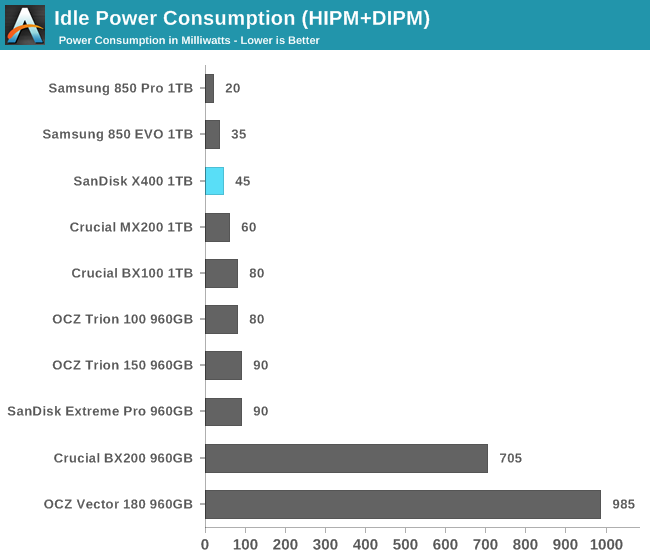
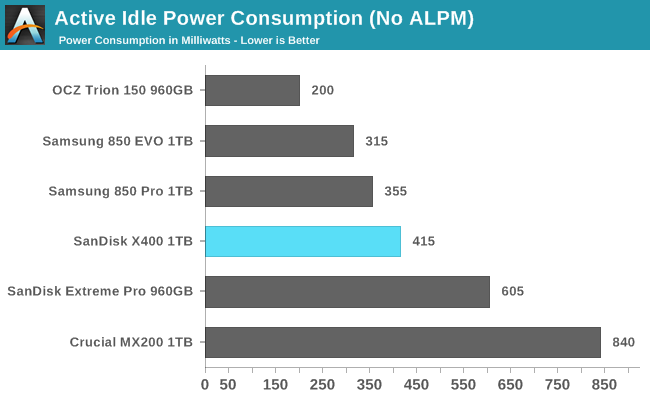
Slumber power drawn by the X400 is not quite the lowest but is still pretty good, but active idle power is twice as high as the OCZ Trion 150 based on the Toshiba TC58/Phison S10 controller platform.










41 Comments
View All Comments
Billy Tallis - Friday, May 6, 2016 - link
I changed TiB to TB. In reality the sizes are only nominal. The exact capacity of the X400 is 1,024,209,543,168 bytes while 1TiB would be 1,099,511,627,776 bytes and 1000GB drives like the 850 EVO are 1,000,204,886,016 bytes.HollyDOL - Friday, May 6, 2016 - link
yay, that's some black magic with spare areas / crc prossibly...X vs Xi prefixes are treatcherous... while with kilo it does only 2,4%, with Tera it's already 9,95%...more than enough to hide OS and majority of installed software :-)
bug77 - Tuesday, May 10, 2016 - link
Then you should put that into the article, unless you're intentionally trying to be misleading ;)SaolDan - Friday, May 6, 2016 - link
Neat!!hechacker1 - Friday, May 6, 2016 - link
I'm tempted to buy two 512GB and RAID 0 them. Does anybody know if that would improve performance consistency compared to a single 1TB drive? I don't really care about raw bandwidth, but 4k IOPS for VMs. I'm having trouble finding benchmarks showing what RAID 0 does to latency outliersCaedenV - Friday, May 6, 2016 - link
As someone who has been running 2 SSDs in RAID0 for the last few years I would recommend against it. That is not to say that I have had any real issues with it, just that it is not really worth doing.1) once you have a RAID your boot time takes much longer as you have to POST, RAID, and then POST again, then boot. This undoes any speed benefit for fast start times that SSDs bring you.
2) It adds points of failure. Having 2 drives means that things are (more or less) twice as likely to fail. SSDs are not as scary as they use to be, but it is still added risk for no real world benefit.
3) Very little real-world benefit. While in benchmarks you will see a bit of improvement, real world workloads are very bursty. And the big deal with RAID with mechanical drives is the ability to que up read requests in rapid succession to dramatically reduce seek time (or at least hide seek time). With SSDs there is practically no seek time to begin with, so that advantage is not needed. For read/write performance you will also see a minor increase, but typically the bottleneck will be at the CPU, GPU, or now even the bus itself.
Sure, if you are a huge power-user that is editing multiple concurrent 4K video streams then maybe you will need that extra little bit of performance... but for most people you would never notice the difference.
The reason I did it 4 years ago was simply a cost and space issue. I started with a 240GB SSD that cost ~$250 which was a good deal. Then when the price dropped to $200 I picked up another and put it in RAID 0 because I needed the extra space and could not afford a larger drive. Now with the price of a single 1TB drive so low, and with RAID having just as many potential issues as potential up-sides, I would just stick with a single drive and be done with it.
Impulses - Friday, May 6, 2016 - link
I did it with 2x 128GB 840s at one point and again last year for the same reasons, cost and space... 1TB EVO x2 (using a 256GB SM951 as OS drive) If I were to add more SSD space now I'd probably just end up with a 2TB EVO.Probably won't need to RAID up drives to form a single large-enough volume again in the future, this X400 is already $225 on Amazon (basically hours after the article went up with the $244 price).
I don't even need the dual 1TB in RAID in an absolute sense, but it's more convenient to have a single large volume shared by games/recent photos than to balance two volumes.
I don't think the downsides are a big deal, but I wouldn't do it for performance reasons either, and I backup often.
phoenix_rizzen - Friday, May 6, 2016 - link
Get 4 of them and stick them into a RAID10. :)Lolimaster - Friday, May 6, 2016 - link
There's no point in doind raid0 with SSD's. You won't decrease latency/access times or improve random 4k reads (they will be worse most of the time).Sequential gains are meaningless (if it matter to you then you should stick to a PCI-e/m.2 NVME drive)
Pinn - Friday, May 6, 2016 - link
I have the Samsung NVME M.2 512gb in the only m.2 slot and am aching to get more storage. Should I just fill one of my PCIe slots (x99)?